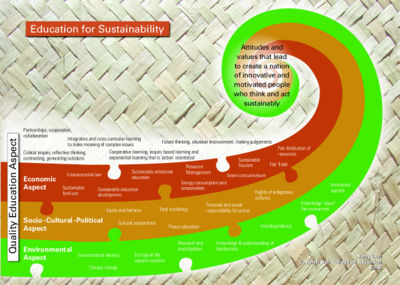Sustainable Ed
Contents
Introduction
In this topic you will be exploring the meaning of sustainability for your teaching practice and for your learners. This includes thinking about the 'greening' of education, and how to create a lot out with the smallest possible a footprint. Sustainable approaches influence student and teacher workloads and are strongly linked to open education resources (OER) and practices (OEP). You need to figure out how you can be a more sustainable educator. It is also about using teaching approaches that support effective pedagogy and action competence: Co-operative learning, Inquiry learning, Experiential learning and Reflection. Some principles are general to all teachers (e.g., workloads and definitions of OER) and others will be specific to your context (e.g., embedding principles of sustainability specific to your discipline, and using open resources).
Learning Objectives
- Explore the principles of sustainable educational practice.
- Investigate Open Education Resources and Practices.
- Review the sustainability of your learning and teaching environment.
- Select learning and teaching strategies can you introduce to support sustainability.
Sustainable educators
Before you can become a sustainable educator, it is necessary to understand the concept of sustainability in an educational context. In this context, sustainability relates to the effectiveness of the learning and teaching environment, in terms of energy expenditure, resourcing, effective pedagogy and cost-effectiveness. For example, do the learning and teaching strategies encourage co-operation, inquiry, experiential learning and reflection? Is the workload for teachers and students manageable? This will depend on how course materials, activities, assessments and class interactions are designed and developed. Do your teaching methods support learning that is cost-effective and enduring while providing a high quality experience for students?
Nice to have resources
|
Open Education Resources (OER) and Practices (OEP)
Debate about what constitutes open education resources and practices has been going on since the OER term was defined in 2002. You are referred to a literature review by Ruth Jelley (2013) to find out what this means. When considering using or creating open education resources, it is important to understand the protocols such as using open licences for materials so that they can be re-used. Also, if OER use is to be successful, teachers need to understand how to collaborate and share resources not only with students but also with colleagues, and how to become more involved in online social networks and communities.
Examples of open courses
Lots of organisations are now offering open courses which are available to anyone who has access to a computer or mobile device and the Internet. Here is a list of some of the more commonly known ones.
- Coursera
- edx
- Futurelearn
- Harvard open extension courses
- OERu (Open Education Resource university
- Open University
- Yale open courses
Must have resources
Nice to have resources
|
Additional resources
- Review Chapter 9 - Roy, S., Benayas, J. & Pérezin, J. (2002). Learning in sustainable environments: the greening of higher education. In Tilbury, D., Stevenson, R.B., Fien, J., Schreuder, D., (eds.) Education and Sustainability: Responding to the Global Challenge. Commission on Education and Communication, IUCN, Gland, Switzerland and Cambridge, UK.
- Education for Sustainability (EfS) - Otago Polytechnic course resources.
- Investigate OER at Otago Polytechnic.
- Some good videos available in Open Education Practices: A User Guide for Organisations.
- Example of an open resource developed by a teacher: Wikibook - Anatomy and Physiology of Animals - students can access online and download pdf. Easy to update. Also available on Lulu.

